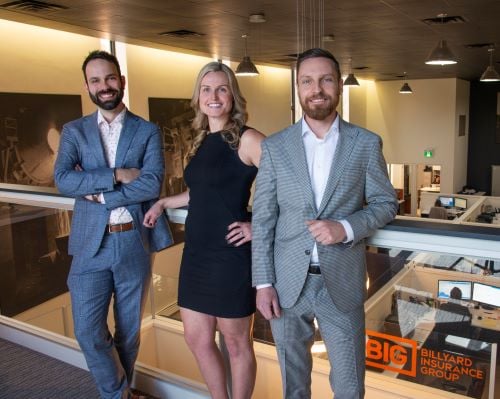

Left to right: Cody Douma – Vice President, Cindy Billyard – Vice President, Stephen Billyard – President
At a time when everybody in insurance seems to be engrossed with ideas around insurtech, mass consolidation and market disruption, there are some brokerages in Canada that are thriving in the good, old-fashioned way.
Ontario-based Billyard Insurance Group (BIG) is one such brokerage to hold faith in the traditional broker toolkit. In 2018, the brokerage experienced considerable growth, opening 16 new offices in key locations across Ontario, and adding 98 licensed brokers to its workforce. Since BIG’s founding in 1998, the brokerage has expanded into 26 locations and now has approximately 195 brokers.
“Over the last few years, we’ve experienced some really explosive growth. We’ve added a lot of locations and a lot of talented brokers across Ontario,” said BIG President Stephen Billyard. “Our growth has been exclusively organic. We’ve been focused on a more traditional, old-fashioned approach to brokerage growth, which is to rely on talented brokers selling in their local communities, developing personal networks, getting involved in those communities, and selling insurance to people face-to-face.”
The old-fashioned ‘boots on the ground’ approach has certainly worked for BIG. By focusing on talent acquisition in local communities, the brokerage has built a thriving book of personal lines business (despite challenges in the industry regarding profitability) and has achieved significant growth in commercial lines. BIG was recently named one of Insurance Business Canada’s Top 10 Brokerages 2019 for its efforts.
“We’ve had a lot of success in commercial lines this year under the leadership of Mark Whiteley, our director of commercial lines,” Billyard told Insurance Business. “We really put an emphasis on developing commercial expertise and talent in the organization. We think there’s a deficit of that in the Ontario marketplace and a lot of the talent is focused around a small number of ageing brokers. To address that, we developed our ‘BIG Commercial Bootcamp,’ where we take largely personal lines producers and we give them the foundations they need to develop small- and mid-market commercial sales strategies.”
Another way BIG has helped its broker force is by investing in new technology. The business might run off old-fashioned ideals, but that culture is supported by the most useful modern technologies. As Billyard put it: “If you give someone who is already a successful broker a powerful tool to help them do their job more effectively, communicate with clients better, and close their sales faster and more effectively – that methodology will draw a lot of success.”
One tool BIG has invested in is a client-facing service app. This gives BIG clients the opportunity to chat directly with their broker, making communication easier and more efficient. Policyholders can also use the app to access their policy documents, find information about billing schedules, request copies of policy documents, and report claims. In the second quarter of 2019, BIG also plans to launch an AI chatbot on its website, which will provide instant customer self-service.
“When it comes to the sales cycle in the brokerage industry right now, clients still want to talk to an insurance professional and they still need a trusted advisor,” said Billyard. “That’s why we believe wholeheartedly in selling insurance in our communities as opposed to selling exclusively online. Of course, selling online remains very important to us as well, but selling in our communities and becoming that trusted advisor is the first step towards building that relationship with the customer.”
“What has changed is that customers today have expectations of a very high level of service and self-service. They want to be able to access important information on their phones or online. They want to be able to communicate with their brokers through their mobile devices, and they want technology to be able to self-service as much as possible. That’s why we’re investing in these tools. I don’t think insurance should be one way or the other; these days, I think customers demand both.”
